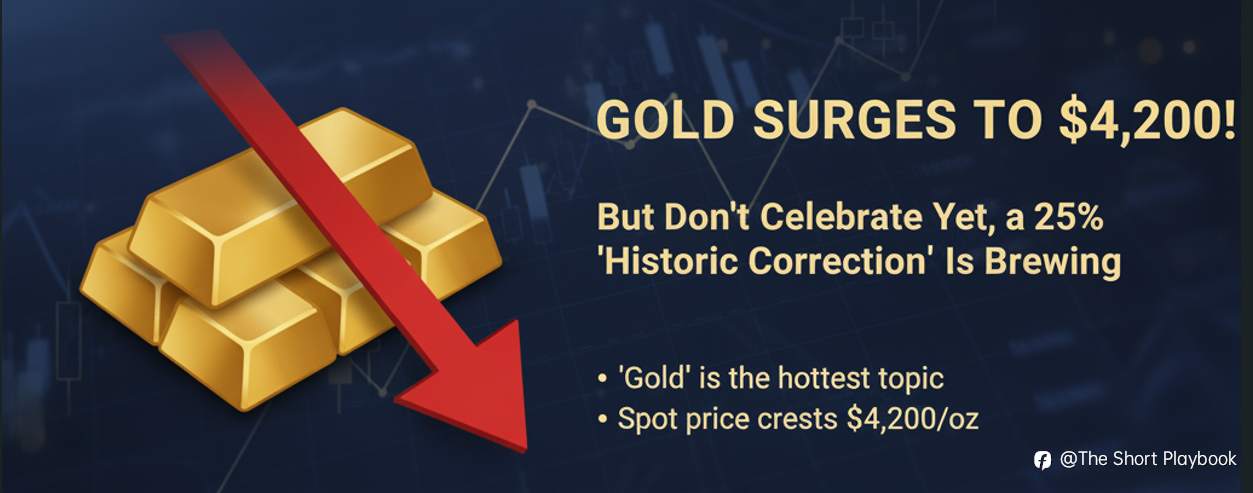
When "gold" becomes the hottest topic at social gatherings and in group chats, and when the spot price historically crests the $4,200 per ounce peak, the entire market seems to be gripped by a frenzy of FOMO (Fear of Missing Out).
However, it is precisely in moments of such clamor that calm scrutiny is most needed.
Just as retail investors pile in frantically through ETFs, chasing the next new high, we must sound an unwelcome note of caution: the current gold banquet may be nearing its end. A deep corrective storm of 20-25% could strike within the next 3-6 months, potentially driving the price back to the 3,200-3,400 range.
This is not alarmism but a sober analysis based on fundamentals, technicals, market sentiment, and the movements of industry capital.
1. A Price "Untethered": Seriously Detached from Fundamental Gravity
The price of any asset must eventually revert to its value anchor. The current price of $4,200 for gold is like a spaceship that has broken orbit, flying far from its fundamental support.
According to the Gold Model 2.0 constructed by the authoritative institution CICC, gold's long-term rational value anchor lies between $3,000 and $5,000. It is crucial to note that $4,200 has already deviated significantly towards the upper band of this equilibrium range.
Top Wall Street investment banks have issued similar warnings. In its latest mid-year outlook, Morgan Stanley provided a Q2 2026 base case price target of just $3,250—implying a potential downside of as much as 23% from the current price.
Broader macroeconomic data reveals even greater risks. A research report from Citibank (Chart 13) clearly indicates that global gold expenditure as a percentage of GDP has climbed to 0.5%, the highest level in half a century. Historically, every time such an extreme valuation has been reached, it has ended in a substantial correction.
2. Technical "Alarms": Topping Signals Are Now Clearly Visible
If fundamentals are a distant concern, the technical picture is sounding a more immediate alarm.
Although gold prices appeared unstoppable in early October, a series of divergence signals are telling us that the bulls' strength is nearly exhausted:
High-Level Volatility: On October 10, as the dollar rebounded, spot gold plummeted 1.62% in a single day, instantly falling from its highs to $3,976, demonstrating the market's fragility at elevated levels.
Profit-Taking: On the very day that gold futures first broke the $4,000 barrier, significant profit-taking emerged, showing signs of large players "distributing into the rally."
Overbought Indicators: The RSI indicator, which reflects market momentum, has remained persistently in overbought territory. Historical experience shows that such conditions are, almost without exception, followed by a correction of at least 10-15%.
As Deutsche Bank warned back in April when gold was at a lower price, one "cannot expect to turn back time." The current price has already priced in far too many overly optimistic expectations.
3. "Waning" Momentum: The Three Main Engines Are Quietly Stalling
The core drivers that have propelled the gold bull market are also weakening at the margin.
Fading Safe-Haven Premium: On October 9, news that Hamas had agreed to a ceasefire proposal sent gold prices tumbling by $33 in a short period. This clearly demonstrates that the safe-haven premium derived from geopolitical risk is rapidly diminishing.
The Dollar May Stage a Comeback: The market's widespread expectation of a Federal Reserve rate cut may be overly optimistic. The minutes from the September Fed meeting revealed that policymakers remain highly cautious about inflation. Future monetary policy may be more "hawkish" than the market anticipates, which would put pressure on gold.
Slowing Central Bank Purchases: The frenzied buying by global central banks was a major driver of the earlier price rally. However, Citibank notes that central bank demand "has receded from its peak." Meanwhile, gold ETFs, the primary channel for retail participation, saw significant outflows in April and May, casting doubt on the sustainability of future inflows.
4. Who Is Exiting? And Who Is Buying In?
When the market is in a frenzy, the most alarming signal is the divergence between "smart money" and "popular sentiment."
On one hand, the market is rife with classic "FOMO" sentiment. Comments by Bridgewater founder Ray Dalio recommending a 15% allocation to gold have been over-interpreted, retail investors are piling in, and speculative net-long positions are at historical extremes. UBS had warned of this "irrational exuberance" when gold broke $3,000, a warning that has now come to pass.
On the other hand, industry capital—the players who know the gold industry best—are quietly making their exit:
Producers Are Hedging: The Citibank report shows that gold producers are actively using the $3,900 forward price to lock in future profits.
Miner Performance is Peaking: The profit margins of high-cost miners have reached their highest point in half a century, creating immense and imminent hedging pressure.
Weak Physical Demand: High prices are deterring actual consumers. A report from Morgan Stanley shows that jewelry demand has already fallen by 19% year-over-year.
Professional Advice: Responding Rationally to Bubble Risk
In summary, gold's short-term risk-reward ratio has severely deteriorated. We anticipate the following three scenarios:
Technical Correction (50% probability): The price falls back to the 3,700−3,800 range to find technical support.
Cyclical Adjustment (30% probability): The price drops back to our core target range of 3,200−3,400.
Panic Selling (10% probability): An extreme event occurs, pushing the price below the psychological barrier of $3,000.
For the rational investor, the current course of action should be:
Position Management: Consider trimming current gold allocations by 30-40% to lock in profits.
Stop-Loss Placement: Set $3,800 as a key technical support level and stop-loss line.
Alternative Options: Consider reallocating capital to more reasonably valued industrial metals or cash assets, and wait for a better entry point.
Conclusion
The long-term bull case for gold (de-dollarization, inflation hedging) may still be intact, but this does not mean its price can defy the laws of gravity indefinitely.
History has repeatedly taught us that when an asset becomes the hot topic of street-level conversation, it is often the signal for rational investors to begin their exit. At the dazzling $4,200 mark, prudence is far wiser than greed.
风险提示:本文所述仅代表作者个人观点,不代表 Followme 的官方立场。Followme 不对内容的准确性、完整性或可靠性作出任何保证,对于基于该内容所采取的任何行为,不承担任何责任,除非另有书面明确说明。


加载失败()